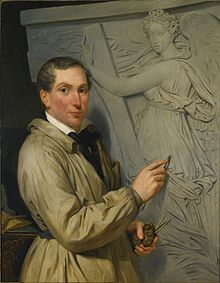Charles-René Laitié
| Charles-René Laitié | |
|---|---|

Portrait of Charles-René Laitié sculpting la Force c. 1824
|
|
| Born | 1782 Paris, France |
| Died | 11 December 1862 Paris, France |
| Nationality | French |
| Occupation | Sculptor |
Charles-René Laitié (1782 – 11 December 1862) was a French sculptor.
Charles-René Laitié was born in Paris in 1782. He became a pupil of Claude Dejoux (1732–1816). He also studied under Pierre Cartellier. He won a medal from the Royal School in the year XII, and the Grand Prix de Rome in 1804. The prize was awarded for his Méléagre refusant son secours aux habitans de Calydon. While in Rome in 1806 Laitié made a plaster model of Homer. In 1827 he presented a small bronze at the Salon from this model, with the date 1806.
In 1820 Laitié was commissioned by the state to make a statue of Jean de La Fontaine, the poet. It was exhibited in the salon in 1822 and installed in Château-Thierry on 6 November 1824. He won a gold medal at the Salon of 1824. The sculptor Claude André Deseine had made a large sculpture of General Colbert during the First French Empire. Under Louis Philippe Laitié transformed it into a statue of Marshal Mortier, which was placed in the first court of the palace of Versailles. In 1963 it was moved to Le Plessis-Trévise, the marshal's home town.
In 1830 Laitié made the central figure of Charity for the portico of Notre-Dame-de-Lorette, Paris. It is flanked by Faith by Denis Foyatier and Hope by Philippe Henri Lemaire.
Laitié's works include:
...
Wikipedia
